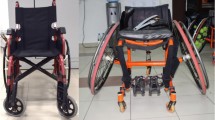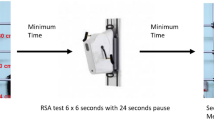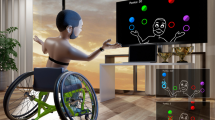Abstract
Study design: Validation of a new wheelchair racing test.
Objective: To assess the reproducibility of test parameters at different, subjectively chosen, intensity levels in wheelchair racing athletes.
Setting: Swiss Paraplegic Centre, Nottwil, Switzerland.
Subjects: We tested 11 (eight male, three female) young competitive wheelchair racing athletes. Their age was 20.5±6.4 years, height 164.7±16.3 cm and weight 54.1±9.2 kg. Average weekly training time was 6.8±2.7 h. All had been engaged in regular training for over 3.9±2.8 years.
Methods: Within a period of 3±1 days, every athlete completed two identical tests in their own racing chair on a training roller. The tests consisted of five 1500 m bouts at routine training intensities of 1 (warm-up) up to 5 (race speed), with a rest of 2 min between each bout. The athletes were blinded to all the collected data during the whole of the test, except for indications of the 500, 1000 and 1500 m markers. We measured the overall time (for 1500 m), average speed, stroke frequency, heart rate, rate of perceived exertion (RPE) and the concentration of lactic acid for all five intensity bouts. In order to get a measure on how reproducible these intensity levels were, we compared the two tests of each athlete with each other, and calculated the root-mean-squared coefficients of variation (CV) for all measured parameters during every bout.
Results: CVs of the measured data show that the most reproducible values were found for bout 5 (2.6–7.9%); except for the lactic acid parameter. The heart rate (CV: 3.1–6.4%) and stroke frequency (CV: 6.5–7.9%) parameters reached rather constant values throughout all five bouts. Lactic acid concentrations showed very high CVs (16.8–29.7%).
Conclusion: We conclude that this test is, with the exception of the lactic acid measurements, well reproducible, and particularly suitable for young wheelchair athletes. We find it to be a helpful tool for improving awareness for the individual training intensities, and for pursuing the development of the training process, as particularly the high-intensity bouts are well reproducible.
Similar content being viewed by others
Log in or create a free account to read this content
Gain free access to this article, as well as selected content from this journal and more on nature.com
or
References
Bhambani Y . Physiology of wheelchair racing in athletes with spinal cord injury. Sports Med 2002; 32: 23–51.
Schabort EJ, Hopkins WG, Hawley JA . Reproducibility of self-paced treadmill performance of trained endurance runners. Int J Sports Med 1998; 19: 48–51.
Ceci R, Hassmen P . Self-monitored exercise at three different RPE intensities in treadmill vs field running. Med Sci Sports Exerc 1991; 23: 732–738.
Okura T, Tanaka K . A unique method for predicting cardio respiratory fitness using rating of perceived exertion. J Physiol Anthropol Appl Hum Sci 2001; 20: 255–261.
Dunbar CC et al. The validity of regulating exercise intensity by ratings of perceived exertion. Med Sci Sports Exerc 1992; 24: 94–99.
Perez-Landaluce J et al. Physiological differences and rating of perceived exertion (RPE) in professional, amateur and young cyclists. J Sports Med Phys Fitness 2002; 42: 389–395.
Schabort EJ, Hawley JA, Hopkins WG, Mujika I, Noakes TD . A new reliable laboratory test of endurance performance for road cyclists. Med Sci Sports Exerc 1998; 30: 1744–1750.
Goosey VL, Campbell IG, Fowler NE . Effect of push frequency on the economy of wheelchair racers. Med Sci Sports Exerc 2000; 32: 174–181.
Borg GAV . Psychophysical bases of perceived exertion. Med Sci Sports Exerc 1982; 14: 377–381.
Andreacci JL, Le Mura LM, Cohen SL, Urbansky EA, Chelland SA, von Duvillard SP . The effects of frequency of encouragement on performance during maximal exercise testing. J Sports Sci 2002; 20: 345–352.
Spriet LL . Caffeine and performance. Int J Sport Nutr 1995; 5: 84–99.
Glüer CC, Blake G, Lu Y, Blunt BA, Jergas M, Genant HK . Accurate assessment of precision errors: how to measure the reproducibility of bone densitometry techniques. Osteoporosis Int 1995; 5: 262–270.
Devillard X et al. Validation of a new ergometer adapted to all types of manual wheelchair. Eur J Appl Physiol 2001; 85: 479–485.
Hickey MS, Costill DL, McConell GK, Widrick JJ, Tanaka H . Day to day variation in time trial cycling performance. Int J Sports Med 1992; 13: 467–470.
Jeukendrup A, Saris WHM, Brouns F, Kester ADM . A new validated endurance performance test. Med Sci Sports Exerc 1996; 28: 266–270.
Kuipers H, Verstappen FTJ, Keizer HA, Geurten P, van Kranenburg G . Variability of aerobic performance in the laboratory and its physiologic correlates. Int J Sports Med 1985; 6: 197–201.
Hutzler Y, Vanlandewijck Y, Vlierberghe MV . Anaerobic performance of older female and male wheelchair basketball players on a mobile wheelchair ergometer. Adapt Phys Activity Q 2000; 465, (Abstract).
Eston RG, Williams JG . Reliability of ratings of perceived effort regulation of exercise intensity. Br J Sports Med 1988; 22: 153–155.
Stephens DE, Janz KF, Mahoney LT . Goal orientation and ratings of perceived exertion in graded exercise testing of adolescents. Percept Motor Skills 2000; 90: 813–822.
Eston RG, Williams JG . Exercise intensity and perceived exertion in adolescent boys. Br J Sports Med 1986; 20: 27–30.
Bhambhani YN, Eriksson P, Steadward RD . Reliability of peak physiological responses during wheelchair ergometry in persons with spinal cord injury. Arch Phys Med Rehabil 1991; 72: 559–562.
Washburn RA, Montoye HJ . Reliability of the heart rate response to submaximal upper and lower body exercise. Res Quart Exerc and Sport 1985; 56: 166–169.
Mahon AD, Del Corral P, Howe CA, Duncan GE, Ray ML . Physiological correlates of 3-kilometer running performance in male children. Int J Sports Med 1996; 17: 580–584.
Beneke R, Heck H, Schwarz V, Leithauser R . Maximal lactate steady state during the second decade of age. Med Sci Sports Exerc 1996; 28: 1474–1478.
Williams JR, Armstrong N, Kirby BJ . The 4 mM blood lactate level as an index of exercise performance in 11–13 year old children. J Sports Sci 1990; 8: 139–147.
Kemper HC, Verschuur R . Longitudinal study of maximal aerobic power in teenagers. Ann Hum Biol 1987; 14: 435–444.
Almarwaey OA, Jones AM, Tolfrey K . Physiological correlates with endurance running performance in trained adolescents. Phys Fitness Perf 2003; 35: 480–487.
Liow DK, Hopkins WG . Training practices of athletes with disabilities. Adapt Phys Activity Q 1996; 13: 372–381.
Chow JW, Mindock LA . Discus throwing performances and medical classification of wheelchair athletes. Med Sci Sports Exerc 1999; 31: 1271–1279.
Author information
Authors and Affiliations
Rights and permissions
About this article
Cite this article
Müller, G., Odermatt, P. & Perret, C. A new test to improve the training quality of wheelchair racing athletes. Spinal Cord 42, 585–590 (2004). https://doi.org/10.1038/sj.sc.3101611
Published:
Issue date:
DOI: https://doi.org/10.1038/sj.sc.3101611
Keywords
This article is cited by
-
Prediction of peak oxygen uptake from differentiated ratings of perceived exertion during wheelchair propulsion in trained wheelchair sportspersons
European Journal of Applied Physiology (2014)
-
Perceived exertion as a tool to self-regulate exercise in individuals with tetraplegia
European Journal of Applied Physiology (2013)
-
Rating of perceived exertion during two different constant-load exercise intensities during arm cranking in paraplegic and able-bodied participants
European Journal of Applied Physiology (2011)



